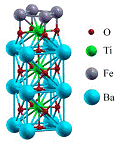Department of Physics and Astronomy: Publications and Other Research
Date of this Version
2010
Abstract
Using first-principles density-functional calculations, we demonstrate that ferromagnetism can be induced and modulated on an otherwise paramagnetic Pd metal thin-film surface through application of an external electric field. As free charges are either accumulated or depleted at the Pd surface to screen the applied electric field, there is a corresponding change in the surface density of states. This change can be made sufficient for the Fermi-level density of states to satisfy the Stoner criterion, driving a transition locally at the surface from a paramagnetic state to an itinerant ferromagnetic state above a critical applied electric field, Ec. Furthermore, due to the second-order nature of this transition, the surface magnetization of the ferromagnetic state just above the transition exhibits a substantial dependence on electric field, as the result of an enhanced magnetoelectric susceptibility. Using a linearized Stoner model, we explain the occurrence of the itinerant ferromagnetism and demonstrate that the magnetic moment on the Pd surface follows a square-root variation with electric field, m ∞ (E - Ec)1/2 consistent with our first-principles calculations.


Comments
Published in PHYSICAL REVIEW B 81, 064413 (2010). Copyright ©2010 The American Physical Society. Used by permission.